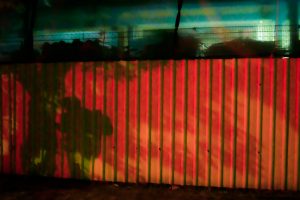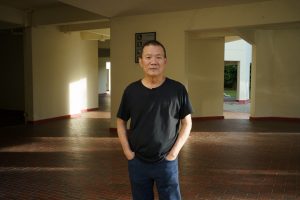All images: Reeta Raman
It’s mid-afternoon in the sweltering heat, and Hasshim Ahmad is trying to repair an old extension cord. In his hand is a massive roll of transparent adhesive tape. He fumbles for a while with the tape, then reaches behind him awkwardly—seated because his feet look like swollen balloons—to grab a pair of black scissors. He’s a fixer.
At 86, he’s spent over half his life in the modest three-room unit along Queen’s Road. The pink and white block he lives in is nondescript, blending seamlessly with the rest of the housing landscape. But Hasshim knows otherwise. That’s because it’s one of about 150 blocks across Singapore without direct lift access for its residents.
Last month, in a parliamentary reply, National Development Minister, Desmond Lee, explained that it was not feasible to implement the Lift Upgrading Programme (LUP) in these blocks due to the high cost or existing technical and site constraints.
It’s a problem Hasshim knows he cannot fix ever since he purchased his unit in 1974. It costs him S$9,000 then, he says proudly. “If I sell now, almost half a million dollars, you know,” he said. But he’s not going to do that. Along with his wife Juminah (she’s 76) and an elder brother, Adnan (he’s 94), the trio forms part of an eclectic mix of residents occupying Block 4.
These stairs were made for walking
The 12-story block is segmented. Two units on each level share one of 10 staircases. Only the units on the second, seventh, and 11th levels have a common corridor and are served by lifts. Lifts A and B are located at one end of the corridor, Lift C at the opposite end.
50-year-old Bryan Tan lives on the ninth level. This means he walks up or down two flights of staircases to access a lift. He has been doing this for close to 20 years.
“It’s a daily thing – up and down. You saw me in the lift earlier, carrying groceries,” he pointed out. “What if a family member is not well? How are we going to bring them down? What about wheelchair access? It is a daily struggle for people here.”
I experienced this first-hand. To write this article, I had to meet some residents. Confused by the design of the block, I walked up and down maze-like flights of steps and narrow corridors to reach some units.
My Fitbit thanked me for the steps I clocked; my feet did not. It made me wonder how elderly residents like Hasshim could do this daily.
“Stop, I can’t breathe.”
“They hobble all the way. I know because I have helped carry their groceries,” Bryan said.
Hasshim and his siblings live on the eighth level. With no direct access to a lift landing, they will need to navigate a labyrinth of steps daily.
“For us younger folks, it’s a five minutes’ walk,” Bryan, a trainer, said. “For them, it’s about 30 minutes. They hobble all the way, and halfway through, they say stop, I can’t breathe.”
When I ask Hasshim about this, he shrugs. “I’m not strong anymore. Mostly, I don’t go out,” he said. When he does, it’s for his medical check-up at the National University Hospital (NUH). He had one a few weeks back.
Hasshim has two sons and two daughters. Together with his grandchildren, they help with groceries and send over food. Usually, he stays with one of his daughters at Taman Jurong for three or four days a week.
It’s a familiar story—elderly residents resigned to moving in with their children. Hasshim recalled over 40 years ago, there used to be as many as 25 Malay families living in Block 4. Now, he reckons there might only be as few as 3 to 4 left. Some left to stay with their children.
“Many died,” he sighs.
His next-door neighbour, an elderly lady, is now in an old folks’ home. “Nowadays, many young people live in this block—most of them are renting,” he shares.
Rich man’s paradise
It is no wonder. The block is in the prime District 10 area, “tempat orang kaya (rich people’s place),” Juminah describes with a chuckle. It’s nestled amongst luxury condominiums and rows of landed properties. It’s surrounded by an abundance of wealth and luxury living as far as the eye can see.
Schools such as Nanyang Primary and St Margaret’s Secondary are nearby. Empress market and Farrer Road MRT station are just a stone’s throw away. Westlake restaurant, a popular eatery serving old-school Chinese cuisine, is on level 2 of Block 4. So too are rows of enrichment centres, laundry shops, cafes, mini-marts, and pet shops. In short, it’s all the amenities anyone could need.
It’s also why long-time residents like Hasshim are reluctant to relocate. I tell him that if he buys another flat with direct lift access, he could apply for a Lift access Housing Grant of up to S$30,000. Wouldn’t he enjoy the convenience?
He demurs, shaking his head. “So old. How to move? Can walk around slowly, good enough.”
Residents living in such blocks who urgently need direct lift access because of mobility reasons or medical conditions are eligible for the grant. They can use it when they purchase another flat with direct lift access. As of last December, HDB received 35 complete applications for the funding. Of these, 28 were approved; two are under evaluation.
Residents I spoke to say they have communicated their grievances about not having direct lift access umpteen times to the authorities. The answer is always the same: it’s just not feasible.
The ward’s MP is Christopher de Souza. I attempted to reach out to him through the People’s Association (PA). But they were unable to get back to me by the time this article was published.
Since 2015, HDB has used new technology to install lifts in about 50 blocks previously found unfeasible for LUP. Mr Lee has given the assurance that for the 150 blocks without direct lift access, “HDB will continue to explore new methods to bring down LUP costs, and alternatives to improve accessibility for residents”.
It remains to be seen if this could happen for Block 4.
Location, location, location
Till then, residents like Tan Cheng Ser will have to make do. The retiree is one of the lucky few—he lives on the 11th level, just meters away from Lift C. Tan and his wife moved in 10 years ago. He wanted to stay in Thomson, but “she wanted to be near her parents.”
Still, lift accessibility is not an issue for them. But waiting for the lift to reach their floor is a bugbear, especially when only Lift C serves the ground floor and three other levels, including theirs. Peak periods are the worst.
“Stop and stop. Every time we must wait for the lift to come up. But no choice,” Tan laments. “If too crowded, the lift will break down. But repair is fast. Still, if I’m rushing, then I take the stairs and walk all the way to the ground floor.”
Tan is 75, relatively fit (he’s an avid gardener), and has no intention to relocate. “Just need to wait for the lift. Everything else is ok; location is good.”
He is right—location matters. Property agents say the absence of direct lift access does not have as much impact on the property value if it is in a good location. Typically, the average resale price of a three-room flat is anywhere between S$300,000 and S$350,000 depending on the location, Ong Jack Shen tells me. He’s an Associate Division Director with real estate agency PropNex.
In January this year, a unit at Block 4 sold for as high as $455,000, according to HDB’s Resale Portal. But who’s buying them?
“The younger crowd—those in their 30s maybe. Because they will not face issues obtaining housing loans, unlike those in their 60s,” Shen explains.
Usually, HDB flats depreciate upon crossing the 35-year mark. Block 4 is over 40 years old.
“Sometimes, people buy for sentimental reasons. Maybe they grew up nearby, or their parents lived there. And now, they want to stay in the area. To them, walking up and down a flight of steps to reach a lift is not that big an issue.”
The stairs win
The absence of direct lift access appears mainly due to how Block 4, and a couple of blocks around it, were designed back in the 1970s. Bryan calls it a “lack of strategic thinking” by the authorities. Perhaps there could have been some form of forecast planning, he mulls, “given how Singapore is now facing a fast-ageing population.”
Residents whom I spoke to appear resigned to their predicament—on the one hand, they are reluctant to move because their homes are in a prime location. “Only one bus to Geylang,” Hasshim points out to me. On the other hand, there is the daily hike up staircases to contend with.
Bryan intends to wait it out. “We are still healthy. Until we are forced to move, we will stay.” So, for now, the stairs win.







